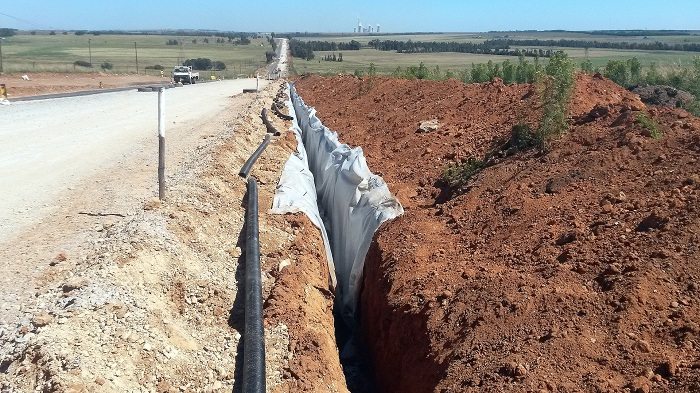Kaytech’s bidim rescues Van Dyksdrift Road
Kaytech’s world renowned bidim was chosen by Endecon Ubuntu Engineering Consultants to solve the drainage problem and significantly extend the life of Van Dyksdrift Road, between Witbank and Middleburg in Mpumalanga.
The ingress of ground water into the layerworks contributed to the ultimate failure of the road and thus the need for reconstruction.
Bidim is a nonwoven, continuous filament, needlepunched geotextile, manufactured from 100% recycled polyester, that has distinct advantages over other man-made fibres, including better modulus of deformation, better plastic yield stability and higher breaking strength.
When incorporated into a subsoil drain, bidim performs the functions, of filtration, drainage and separation where fine soil particles are prevented from entering the drain while water passes through, thus reducing the phreatic surface in the surrounding soil.
With the entry of moisture being the primary cause of road degradation, excavation of trial pits at regular intervals along the length of a road, especially in cuttings and low-lying areas, is the best method to identify the presence of groundwater.
These trial pits form an essential part of a Geotechnical investigation and it was after completing such an exercise, and recognising the problem, that engineers readily specified bidim A4 for Van Dyksdrift Road.
Although drains are usually installed at depths of between 400mm and 500mm, to eliminate the risk of any moisture entering the new layerworks, deeper drains were specified for this project. Edwin Construction excavated trenches to a depth of between 800mm and 1000mm and approximately 400mm wide.
The trenches were then lined with bidim A4 onto which was placed 100mm slotted pipes. 19mm stone was used as drainage medium and a covering of bidim A4 completed the drain. In total, 15,900m2 of bidim was installed.
The geotextile requirements for a subsoil drain include construction survivability, good filtration behaviour, drainage capacity, flexibility, strength and durability. Since Kaytech’s bidim ticks all these boxes, it was the ideal product for this project.
Although the installation of subsoil drainage during this renovation project was somewhat costly for the Mpumalanga Department of Public Works, Roads and Transort, thanks to Kaytech, the premature failure of the road has been prevented.
For more information on Kaytech products and systems, visit www.kaytech.co.za

